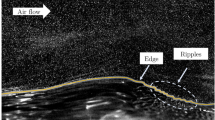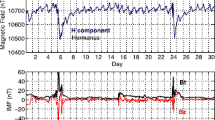Abstract
The measurement of scalar fluxes employing the eddy covariance method is a widely used experimental approach,for which the flow distortion due to obstacles (e.g., sensor mounts and mast)is a well-known but not fully solved problem. In order to reduce flow distortion we installed a sonic anemometer in a surface-normal orientationrelative to the terrain slope, and a second instrument in a verticalposition at a horizontal distance of 1.54 m from the first instrument
We found a significant reduction in the rotation angle necessary for the coordinaterotation procedure in the x-z plane whencomputing 30-minute flux averages with the surface-normal orientation. In 91% of all cases this rotation angleremained within the angle of incidence of ±10° recommended bythe manufacturer. In contrast, only 24% of the measurements taken with the vertically mounted anemometer were obtained at an angle of incidencewithin ±10°, and 3% were outside the ±30° range specified for an acceptable operation.
A data quality test based on the variance of vertical windspeed normalized with friction velocity (σw/u*) revealed problems for application under stable conditions due to large uncertainties in the determination of the Monin–Obukhov stability parameter z/L. An alternative test using the bulk drag coefficient CD revealed other problems related to the dependence of CD on z/z0, the measuring height normalized by the roughness length, which do not appear to be constantin complex terrain. With both tests, a tendency for a slightly improved dataquality was found for the surface normal set-up, which, however, proved statistically insignificant.
It is concluded that the surface-normal set-up of a sonic anemometer significantly reduces flow distortion by thesensor head. Although the surface-normal mounting position therefore appears to be the preferred one, with decreased flow distortion and a slightly improved data quality, no significant differences in turbulent quantities were found between the two set-uppositions. Hence, the consequences for short-term measurements of massand energy fluxes with a surface-normal set-up in complex terrain appearto be relevant only if single flux events are to be inspected, while for long-term measurements of integrated fluxes both the surface-normaland vertical installation of the sonic anemometer are adequate,indicating that eddy covariance measurements in complex terrain are lessdelicate than expected.
Similar content being viewed by others
References
Arya, S. P. S.: 1988, Introduction to Micrometeorology, Academic Press, San Diego, 307 pp.
Baldocchi, D., Valentini, R., Running, S., Ocehel, W., and Dahiman, R.: 1996, ‘Strategies for Measuring and Modeling Carbon Dioxide and Water Vapour Fluxes over Terrestrial Ecosystems’, Global Change Biol. 2, 159-168.
Barry, R. G.: 1992, Mountain Weather and Climate, Routledge, New York, 402 pp.
Blanken, P. D., Black, T. A., Yang, P. C., Neumann, H. H., Nesic, Z., Staebler, R., den Hartog, G., Novak, M. D., and Lee, X.: 1997, ‘Energy Balance and Canopy Conductance of a Boreal Aspen Forest’, J. Geophys. Res. 102, 28915-28927.
Cernusca, A., Tappeiner, U., Bahn, M., Bayfiled, N., Chemini, C., Fillat, C., Graher, W., Rosset, M., Siegwolf, R., and Tenhunen, J.: 1996, ‘ECOMONT: Ecological Effects of Land Use Changes on European Terrestrial Mountain Ecosystems’, Pirineos 147/148, 145-172.
DeFelice, T. P.: 1998, An Introduction to Meteorological Instrumentation and Measurement, Prentice Hall, Upper Saddle River, NJ, 229 pp.
Eugster, W.: 1994, Mikrometeorologische Bestimmung des NO 2 -Flusses an der Grenzfläche Boden/Luft, Vol. G37 of Geographica Bernensia, Geographica Bernensia, Bern, 164 pp. ISBN 3-906290-90-5.
Eugster, W. and Senn, W.: 1995, ‘A Cospectral Correction Model for Measurement of Turbulent NO2 Flux’, Boundary-Layer Meteorol. 74, 321-340.
Foken, T. and Wichura, B.: 1996, ‘Tools for Quality Assessment of Surface-Based Flux Measurements’, Agric. For. Meteorol. 78, 83-105.
Garratt, J. R.: 1992, The Atmospheric Boundary Layer, Cambridge University Press, New York, 316 pp.
Grant, A. L. M. and Watkins, R. D.: 1989, ‘Errors in Turbulence Measurements with a Sonic Anemometer’, Boundary Layer Meteorol. 46, 181-194.
Hicks, B. B. and Millen, R. T. M.: 1988, ‘On the Measurements of Dry Deposition Using Imperfect Sensors and in Non-Ideal Terrain’, Boundary-Layer Meteorol. 42, 79-94.
Kaimal, J. C. and Finnigan, J. J.: 1994, Atmospheric Boundary Layer Flows, Oxford University Press, New York, 289 pp.
Kaimal, J. C. and Gaynor, J. C.: 1991, ‘Another Look at Sonic Thermometry’, Boundary-Layer Meteorol. 56, 401-410.
Kaimal, J. C., Wyngaard, J. C., and Haugen, D. A.: 1968, ‘Deriving Power Spectra from a Three-Component Sonic Anemometer’, J. Appl. Meteorol. 7, 827-837.
Kaimal, J. C., Wyngaard, J. C., Izumi, Y., and Coté, O. R.: 1972, ‘Spectral Characteristics of Surface-Layer Turbulence’, Quart. J. Roy. Meteorol. Soc. 98, 563-589.
Laubach, J. and McNaughton, K. G.: 1998, ‘A Spectrum-Independent Procedure for Correcting Eddy Fluxes Measured with Separated Sensors’, Boundary-Layer Meteorol. 89, 455-467.
McMillen, R.: 1988, ‘An Eddy Correlation Technique with Extended Applicability to Non-Simple Terrain’, Boundary-Layer Meteorol. 89, 455-467.
Miao, M. and Ji, J.: 1996, ‘Study on Diurnal Variation of Bulk Drag Coefficient over Different Landsurfaces’, Meteorol. Atmos. Phys. 61, 217-224.
Moore, C. J.: 1986, ‘Frequency Response Correction for Eddy Correlation Systems’, Boundary-Layer Meteorol. 37, 17-35.
Noether, G. E.: 1991, Introduction to Statistics –-The Nonparametric Way, Springer, New York, 414 pp.
Panofsky, H. A. and Dutton, J. A.: 1984, Atmospheric Turbulence, John Wiley and Sons, New York, 397 pp.
Panofsky, H. A., Tennekes, H., Lenschow, D. H., and Wyngaard, J. C.: 1977, ‘The Characteristics of Turbulent Velocity Components in the Surface Layer under Convective Conditions’, Boundary-Layer Meteorol. 11, 355-361.
Rannik, Ü. and Vesala, T.: 1999, ‘Autoregressive Filtering versus Linear Detrending in Estimation of Fluxes by the Eddy Covariance Method’, Boundary-Layer Meteorol. 91, 259-280.
Skupniewicz, C. E., Kamada, R. E., and Schacher, G. E.: 1989, ‘Turbulence Measurements over Complex Terrain’, Boundary-Layer Meteorol. 48, 109-128.
Stull, R. B.: 1988, An Introduction to Boundary Layer Meteorology, Kluwer Academic Publishers, Dordrecht, 666 pp.
Taylor, G. I.: 1938, ‘The Spectrum of Turbulence’, Proc. Roy. Soc. London Ser. 164, 476-490.
Wagner, A.: 1938, ‘Theorie und Beahachtuiigen der periadisehen Gebirgswinde’, Gerlands Beitr. Geophys. 52, 408-449. [English translation in C. D. Whiteman and F. Dreiseitl: 1984, in A. Wagner, E. Ekhart and F. Defant (eds.), Alpine Meteorology –-Translations of Classic Contributions, PNL-5141/ASCOT-84-3, Pacific Northwest Laboratory, 121 pp.].
Whiteman, C. D. and Doran, J. C.: 1993, ‘The Relationship between Overlying Synoptic-Scale Flows and Winds within a Valley’, J Appl. Meteorol. 32, 1669-1682.
Wyngaard, J. C.: 1981, ‘The Effects of Probe-Inducted Flow Distortion on Atmospheric Turbulence Measurements’, J. Appl. Meteorol. 20, 784-794.
Wyngaard, J. C., Coté, O. R., and Izumi, Y.: 1971, ‘Local Free Convection, Similarity, and the Budgets of Shear Stress and Heat Flux’, J. Am. Sci. 28, 1171-1182.
Author information
Authors and Affiliations
Rights and permissions
About this article
Cite this article
Geissbühler, P., Siegwolf, R. & Eugster, W. Eddy Covariance Measurements On Mountain Slopes: The Advantage Of Surface-Normal Sensor Orientation Over A Vertical Set-Up. Boundary-Layer Meteorology 96, 371–392 (2000). https://doi.org/10.1023/A:1002660521017
Issue Date:
DOI: https://doi.org/10.1023/A:1002660521017




